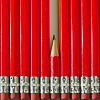Skip over navigation
We begin by assuming that almost everybody has 2 arms. Nobody has 3, but a small number of people have lost one or both arms in accidents or amputations. Here, we will ignore fractional arms - but you don't actually have to.
The next person you meet will probably have 2 arms, and definitely won't have more.
So it is almost certain that they have more than the mean number of arms, but impossible that they have more than the median or modal number of arms.



Or search by topic
Number and algebra
Geometry and measure
Probability and statistics
Working mathematically
Advanced mathematics
For younger learners
Number of Arms
Age 11 to 14
ShortChallenge Level 





- Problem
- Solutions
We begin by assuming that almost everybody has 2 arms. Nobody has 3, but a small number of people have lost one or both arms in accidents or amputations. Here, we will ignore fractional arms - but you don't actually have to.
| Measure | What it is | Value | More than this many arms |
|---|---|---|---|
| Mean | If all of the arms in the world were shared equally between all of the people | Just below 2 | 2 |
| Median | The middle number, when everybody's number of arms is written in a long, ordered list: 0, ..., 0, 1, ..., 1, 2, ..........................................................., 2 |
2 | 3 |
| Mode | The most common number of arms | 2 | 3 |
The next person you meet will probably have 2 arms, and definitely won't have more.
So it is almost certain that they have more than the mean number of arms, but impossible that they have more than the median or modal number of arms.
You can find more short problems, arranged by curriculum topic, in our short problems collection.
You may also like

Bat Wings
Two students collected some data on the wingspan of bats, but each lost a measurement. Can you find the missing information?

Kate's Date
When Kate ate a giant date, the average weight of the dates decreased. What was the weight of the date that Kate ate?

Balancing the Books
How many visitors does a tourist attraction need next week in order to break even?

